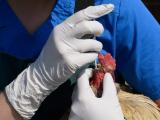Asymptomatic human avian influenza A(H5N1) infections occur, and person-to-person transmission is likely in some settings, reveals a scoping review by US Centers for Disease Control and Prevention (CDC) researchers.
The study, published yesterday in JAMA Network Open, involved a search for studies on confirmed highly pathogenic H5N1 infection published through August 25, 2025.
"Since 1997, more than 1,000 infections with highly pathogenic avian influenza A(H5N1) virus among humans have been reported globally," the researchers wrote. "Given ongoing A(H5N1) outbreaks in animals, understanding the frequency of A(H5N1) virus infections among asymptomatic persons can inform public health risk assessments and infection prevention guidance."
18 symptom-less human infections
The team identified 10 reports of 18 asymptomatic human H5N1 infection, including 2 with molecular and serologic confirmation (MSC) and 16 with molecular confirmation alone (MC).
Robust data collection is needed from persons with possible asymptomatic A(H5N1) virus infection to inform future public health responses.
The two MSC cases occurred in adults in Pakistan and Vietnam who were identified through investigations of household contacts of index H5N1 patients; one patient was also exposed to infected chickens, and the other is believed to have been infected through human-to-human spread, because they had no contact with sick or dead poultry. Neither MSC patient had used personal protective equipment when in close contact with an infected household member or chickens.
Of the 16 MC patients (14 adults and 2 children), 11 were identified through enhanced surveillance of people exposed to poultry infected with H5N1 (8 in Bangladesh, 2 in Spain, and 1 in the United Kingdom), and the remaining 5 patients (3 in Vietnam and 2 in Cambodia) were identified through contact tracing.
"Asymptomatic human infections with A(H5N1) virus have been infrequently reported, with most cases identified through enhanced surveillance or household contact investigations of persons with known exposure," the authors noted. "Robust data collection is needed from persons with possible asymptomatic A(H5N1) virus infection to inform future public health responses."
Gaps in surveillance
In a commentary in the same journal, Rick Bright, PhD, of Bright Global Health, and Nicole Lurie, MD, MSPH, of the Coalition for Epidemic Preparedness Innovations (CEPI) and Harvard Medical School, noted that since March 2024, H5N1 clade 2.3.4.4b has spread among dairy cattle, with confirmed infections in more than 800 herds in at least 16 states.
Human cases have been confirmed in multiple states, and as of mid-2025, approximately 70 cases have been officially reported, most with mild illness but including at least 1 death.
High viral levels have been found in raw milk, and live virus has been detected in mammary tissue and milking equipment.
"Spillover into, and transmission among, other mammals has been documented, including cats, dogs, mice, wild carnivores, marine mammals, and swine," they wrote. "Human cases have been confirmed in multiple states, and as of mid-2025, approximately 70 cases have been officially reported, most with mild illness but including at least 1 death."
Bright and Lurie said the findings challenge the traditional perception that human H5N1 infections are almost always symptomatic and severe and that no human-to-human H5N1 spread has occurred.
"It also highlights a critical gap in many national and global surveillance systems, which tend to focus on the detection of symptomatic illness rather than infection, and underscores the importance of carefully examining clusters where limited transmission may occur," they concluded.



















